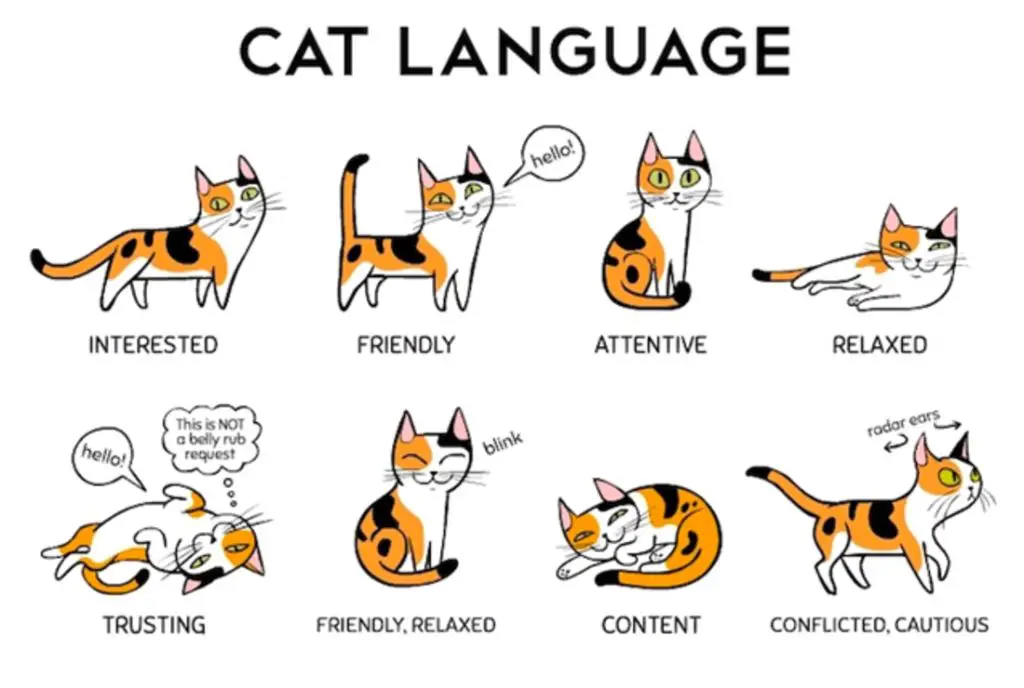There has been much debate over whether cats can actually understand human language or simply respond to sound cues. On one side, some argue that cats do not have the cognitive capabilities to comprehend words and sentences. On the other side, some claim cats can understand human intentions and emotions through vocal tones, gestures, and even certain words. While cats may not understand language to the extent humans do, research shows they can learn to recognize their own names and respond to simple commands. Much of a cat’s understanding comes from non-verbal communication and emotional cues. This article will explore the evidence around cats’ language comprehension skills.
Vocal Communication

Cats have a range of vocalizations that they use to communicate with humans, including meows, purrs, chirps and more. Meowing is one of the most common cat vocalizations that cats use with people. Cats learn to meow specifically to communicate with humans, as adult cats do not meow at each other (https://cats.com/how-do-cats-communicate-with-humans). Meows can express excitement, affection, displeasure, anxiety and more. Kittens meow to their mothers when looking for food or warmth. Cats often meow as a greeting to their owners or to get their attention.
Purring is another friendly cat vocalization, expressing contentment and happiness. Cats may purr more around familiar humans as a sign of affection. Chirping is a lesser known cat vocalization that is thought to indicate a positive mood, similar to purring. Cats also hiss, growl, yowl, shriek and make other sounds to express fear, anger, distress or territorial warnings.
Body Language

Cats use body language like tail, ear, and body postures to communicate how they are feeling. For example, an alert, upright tail with a hooked tip signals a happy, friendly cat. A swishing tail can mean a cat is irritated or angry, especially if the tail is swishing angrily. Ears that are forward and upright show interest and attention, while ears flattened back against the head often indicate an unhappy or frightened cat. A cat with an arched back, puffed out fur, and an upright, bottle-brush tail is feeling threatened and defensive. Relaxed body language, such as half-closed eyes, shows a content, relaxed cat.
Cats also use body postures like rolling over to show submission or vulnerability, or rubbing against people or objects to show affection. Kneading with front paws and treading with back legs are signs of contentment. Understanding a cat’s body language helps owners better interpret their pet’s moods and needs.
Scent Signals

Cats rely heavily on scent signals to communicate. They have scent glands around their bodies that secrete pheromones. When a cat rubs against furniture or scratches furniture or trees, they are depositing pheromones from these scent glands to mark their territory [1]. Their urine also contains pheromones that communicate information about their identity and reproductive status. When cats spray urine, it is a way for them to mark an area and send a stronger scent signal to other cats. Cats have an excellent sense of smell and the pheromones in these scent markings allow them to identify which cats have been in an area.
Cats Respond to Names

Studies have shown that cats can recognize their own names. In one study published in Scientific Reports, researchers found that cats responded more when their owners called their names compared to unfamiliar nouns. The cats’ ears and heads moved more in response to their own names.1
Another study from Sophia University in Japan found that cats reacted more strongly when their owners called their names versus other nouns or phrases. The cats showed more movement and dilation of their pupils, indicating they recognized their names.2
While cats may recognize their names, they don’t always come when called. This is likely because cats are more independent than dogs. However, consistent training can help cats learn to respond more reliably to their names.
Understanding Commands
Cats can learn to understand basic commands like “sit” and “come” with proper training techniques, though they may not respond as reliably as dogs. According to Can Cats Be Trained Like Dogs? Helpful Tips & Advices, cats can comprehend the meaning of words that are consistently associated with rewards or punishments. For example, saying “sit” right before giving a treat each time can teach a cat to sit on command. Using a reward marker like a clicker helps reinforce the connection. Cats may take more repetition than dogs to learn commands, and their response depends on factors like motivation and distractions present.
Tone of Voice
Cats are very sensitive to the tone of a human’s voice and can respond differently based on how something is said. They recognize when their owner uses a higher-pitched, affectionate tone versus a loud, scolding one. According to a study by ScienceDaily, cats may change their behavior when hearing their owner’s voice directed specifically at them.
When using a sweet, calm voice, a cat will often perceive that as happiness and affection from their owner. They recognize the difference between praise and scolding based on tone. Loud, angry tones often signify displeasure to a cat. While cats don’t understand the exact words being spoken, they read human emotions through voice cues. Their response demonstrates an understanding of the meaning behind tones.
Association of Words with Rewards
Cats can learn to associate certain words with rewards like treats or playtime. When a cat hears a word repeatedly in association with something positive happening, they can make the connection. For example, if an owner says “treat” every time before giving their cat a tasty snack, the cat may get excited and meow when they hear “treat.” This is because the cat has learned that the word precedes something good. According to a study published in Scientific Reports, cats can distinguish their own names from other random words. This shows cats are able to identify words they associate strongly with themselves. However, this association of words with rewards does not mean cats actually understand the deeper meaning behind the words. It is simply a learned connection.
As explained in an article on The Dodo, “Scientists say that cats can link vocalizations of 25 to 40 words with particular objects, actions and people.”1 So while they pick up on certain frequently used words, their understanding is limited compared to humans. The level of comprehension depends on the individual cat, its environment, training, and how often the owner uses specific words and phrases. With time and repetition, many cats learn to get excited upon hearing words like “food,” “play,” or even their own names. But it does not necessarily mean they grasp the full meaning behind these words.
Lack of Complex Language Skills
Cats do not have the cognitive abilities to understand complex language and grammar. As domesticated pets, cats can recognize their names andlearn to associate certain words with rewards through training, but they lack the neural capacity for processing syntax or interpreting complex vocabulary and language structures like humans do.
Research indicates cats can differentiate between intonations and recognize familiar words that are regularly used to refer to them specifically, such as their name, words like “treat” or “dinner,” and simple commands like “sit.” However, they do not comprehend the meanings of most human words or the grammatical relationships between them. Their inability to understand grammar and vocabulary limits cats’ capacity for learning human language.
According to veterinary behaviorist Dr. Hill, “Cats just don’t have the same tools we do – namely theInterpreter in our left brain hemisphere – to understand human language.” Instead, cats communicate through vocalizations, scents, and body language tailored to other felines. While they can associate some human words with rewards through training, evidence suggests cats do not possess the neural wiring required to process complex language or syntax.
Conclusion
Cats have a surprising ability to understand different elements of human language and communication. While they lack the more complex language processing skills that humans possess, cats are able to comprehend various vocabulary words, vocal tones, commands, names, and body language cues. This allows them to pick up on the intent behind our words and actions.
Key learnings and takeaways include:
- Cats can recognize their own names and words associated with rewards or punishment.
- They respond to human voices and tone – such as anger, affection, or urgency.
- Cats understand some simple verbal commands like “come” or “no”.
- Body language and scent signals also play a role in cat-human communication.
- While cats don’t have human-level language skills, their ability to comprehend us is quite impressive.
Understanding how cats perceive our words and actions can lead to better bonding and caretaking. While limited compared to human language, a cat’s comprehension still allows meaningful interaction and relationships to develop.

